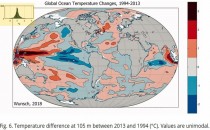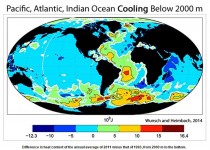A new analysis of top-to-bottom (0-5,000 m or 3.1 miles) ocean heat content changes since the mid-1990s reveals that (a) large regions of the global ocean have undergone cooling, and (b) the overall net temperature change for 1994-2013 was a modest 0.02C.
In contrast, during the Holocene the oceans naturally warmed at a rate and magnitude several times greater than the last few decades, undermining claims that the modern era change is unusual or unprecedented.

Global Warming = Ocean Warming
According to the United Nation’s Intergovernmental Panel on Climate Change (IPCC), the atmosphere accounts for only 1% of the heat energy change in the Earth system, whereas the 0-2,000 meter (0-1.2 miles) layer of the ocean is where 93% of the globe’s overall heat/temperature change has occurred in recent decades.
“Ocean warming dominates the total energy change inventory, accounting for roughly 93% on average from 1971 to 2010 (high confidence).
“The upper ocean (0-700 m) accounts for about 64% of the total energy change inventory.
“Melting ice (including Arctic sea ice, ice sheets, and glaciers) accounts for 3% of the total, and warming of the continents 3%. Warming of the atmosphere makes up the remaining 1%.’ (IPCC, 2013)
Deep Ocean Temperatures Cooling Since The 1990s
The IPCC chooses to exclude the layer of the ocean below 2,000 meters in their energy change inventories, even though about “52% of the ocean lies below 2,000 meters (1.2 miles) and about 18% below 3,600 meters (2.2 miles)” (Wunsch and Heimbach, 2014).
Perhaps the reason the deep ocean is disregarded is that recent analysis has revealed the deep oceans below 2,000 meters (1.2 miles) have been cooling since 1993.
“A very weak long-term [1993-2011] cooling is seen over the bulk of the rest of the ocean below that depth [2,000 m], including the entirety of the Pacific and Indian Oceans, along with the eastern Atlantic basin.” (Wunsch and Heimbach, 2014)

Image Source: (Wunsch and Heimbach, 2014)
Because of the cooling (thermal “retraction") occurring below 2,000 meters, the deep ocean removes a very uncertain -0.13 mm per year from global sea level change estimates (Llovel et al., 2014).
“Over the entire water column, independent estimates of ocean warming yield a contribution of 0.77 plus/minus 0.28 mm yr-1 in sea-level rise ... the deep ocean (below 2,000 m) contributes -0.13 plus/minus 0.72 mm yr-1 to global sea-level rise.” (Llovel et al., 2014)
Top-To-Bottom Global Ocean Temps Have Changed By 0.02C Since 1994...Large Regions Have Undergone Cooling
In a new paper, Harvard oceanographer Carl Wunsch provides an analysis of the overall temperature, salinity, and surface elevation changes in the global ocean for the 20 years between 1994-2013.
He focuses on the profound uncertainties in the data analysis and cautions that we still have much to learn about the ocean system.
Wunsch provides a novel assessment of the temperature data for the whole ocean (0-5,000 m), as the record doesn’t end at the 2,000-meter depth.
The results reveal that the global ocean has been cooling in some regions and warming in others for the last few decades, with an overall net change of 0.02C (~0.001C per year) during 1994-2013.
Read rest at No Tricks Zone




